U.S. Civilian Labor Force, Unemployment Claims and Recession Risk
Economics / Employment Jun 07, 2014 - 01:15 PM GMTBy: PhilStockWorld
 Courtesy of Doug Short: Every week I post an update on new unemployment claims shortly after the BLS report is made available. My focus is the four-week moving average of this rather volatile indicator. The financial press generally takes a fairly simplistic view of the latest number, and the market often reacts, for a few minutes or a few hours, to the initial estimate, which is always revised the following week.
Courtesy of Doug Short: Every week I post an update on new unemployment claims shortly after the BLS report is made available. My focus is the four-week moving average of this rather volatile indicator. The financial press generally takes a fairly simplistic view of the latest number, and the market often reacts, for a few minutes or a few hours, to the initial estimate, which is always revised the following week.
One of my featured charts in the update shows the four-week moving average from the inception of this series in January 1967.
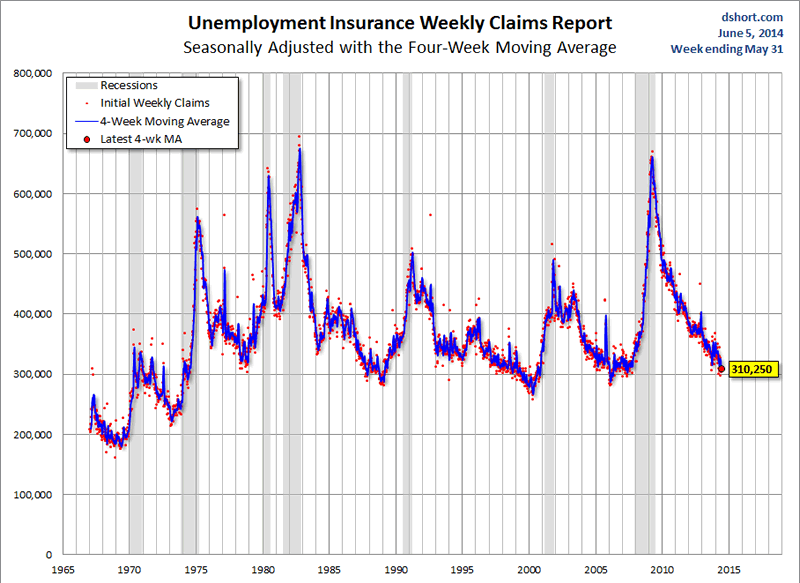
The chart, above, however, gives a rather distorted view of Initial Claims. Why? Because it’s based on a raw, albeit seasonally adjusted, number that doesn’t take into account the 103% growth in the Civilian Labor Force since January 1967, as illustrated here:
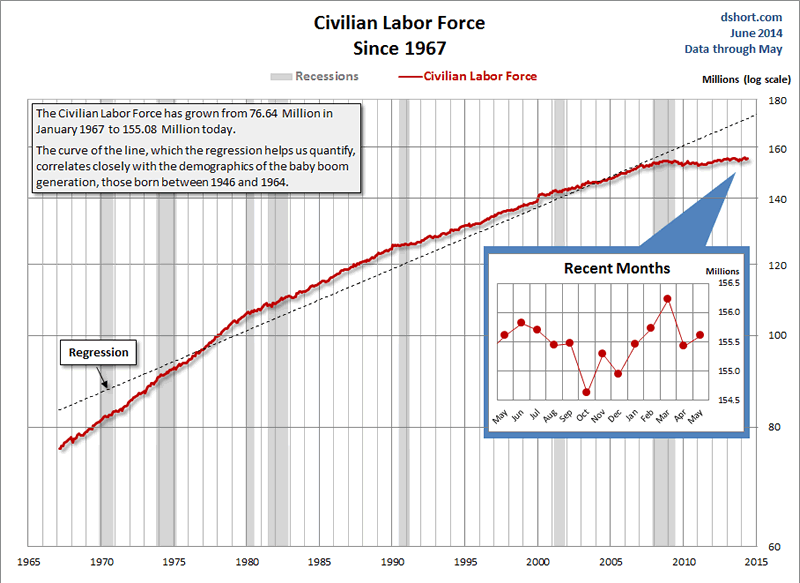
The Civilian Labor Force in the chart above has more than doubled from 76.52 Million in January 1967 to 155.61 Million today. The curve of the line, which the regression helps us visually quantify, largely reflects the employment demographics of the baby boom generation, those born between 1946 and 1964. In 1967 they were starting to turn 21. The oldest are now eligible for full retirement benefits. Another factor is the curve is the rising participation of women in the labor force (see this illustration).
For a better understanding of the weekly Initial Claims data, let’s view the numbers as a percent ratio of the Civilian Labor Force.
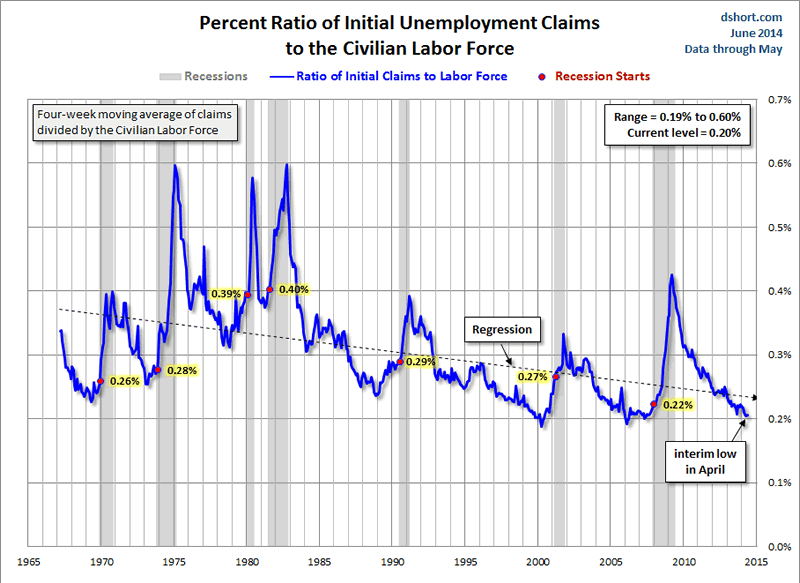
The latest percent ratio of 0.20% means that out of 10,000 workers, twenty made an initial application for unemployment insurance payments in the latest data, fractionally off the interim low set last month. The number during the past year has been hovering just above the low end of the 0.20% to 0.67% range over the last four-plus decades. Initial Claims are substantially below the levels during the business cycles of the stagflation years of the 1970s and early 1980s.
What about Continued Claims? Here is their percent ratio to the Civilian Labor Force.
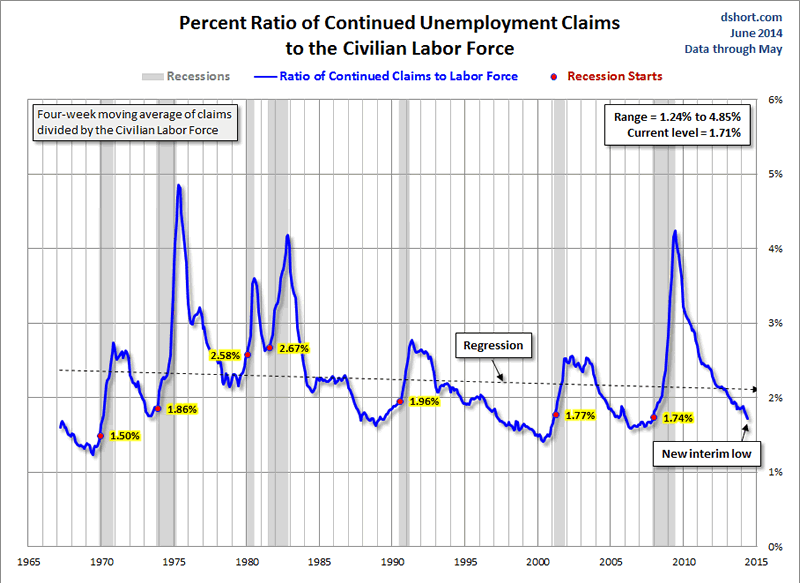
Likewise with this indicator, we’re at the low end of the historic range (1.24% to 4.85%). The latest reading, 1.71%, an interim low, means that approximately eighteen persons per 1,000 are receiving continuing unemployment insurance benefits.
Unemployment Claims as a Recession Indicator
A particularly interesting feature of this Unemployment Claims ratio series is its effectiveness in the past as a leading indicator for recession starts and a virtually dead-on coincident indicator for recession ends. In both of the percent ratio charts above, I’ve highlighted the value at the month a recession starts. In every instance the trough in claims preceded the recession start by a few to many months, but the claims peaks were nearly identical with recession ends. Here is a table showing the actual numbers.
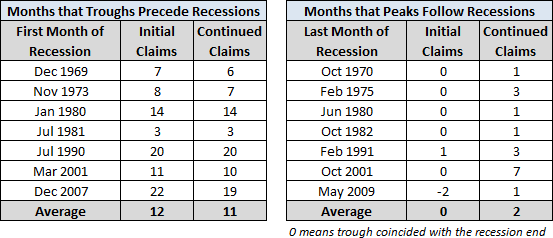
The least lead time from a claims trough to a recession start was three months. That was for the second half of the double-dip that began in July 1981. As I’ve discussed elsewhere, this was basically a Fed engineered recession to break the back of inflation. The Effective Fed Funds Rate hit its historic monthly average high of 19.1% in June of 1981 and its all-time daily high of 22.4% on July 22, the month the NBER subsequently identified as the recession start.
Current Recession Risk
What does the percent ratio of unemployment claims tell us about our current recession risk? At present, the ratio for Continued Claims has been trending down. Excluding the 1981 recession, the Initial Claims trough lead time for a recession has ranged from 7 to 22 months with an average of 12 months if we include the 1981 recession and 14 months if we exclude it. Admittedly, the last recession is an extreme example, but the Initial Claims trough preceded its December 2007 onset by a whopping 22 months.
If history is a guide, the current percent ratios of weekly claims to the labor force contradict the minority view that the US is currently in recession (e.g., ECRI and a few bearish bloggers). Instead, the ratios suggests that even a near-term recession would be months in the future.
For another interesting perspective on employment and recessions see this iM imarketsignals.com update: How Long to the Next Recession?
- Phil
Philip R. Davis is a founder of Phil's Stock World (www.philstockworld.com), a stock and options trading site that teaches the art of options trading to newcomers and devises advanced strategies for expert traders. Mr. Davis is a serial entrepreneur, having founded software company Accu-Title, a real estate title insurance software solution, and is also the President of the Delphi Consulting Corp., an M&A consulting firm that helps large and small companies obtain funding and close deals. He was also the founder of Accu-Search, a property data corporation that was sold to DataTrace in 2004 and Personality Plus, a precursor to eHarmony.com. Phil was a former editor of a UMass/Amherst humor magazine and it shows in his writing -- which is filled with colorful commentary along with very specific ideas on stock option purchases (Phil rarely holds actual stocks). Visit: Phil's Stock World (www.philstockworld.com)
© 2014 Copyright PhilStockWorld - All Rights Reserved Disclaimer: The above is a matter of opinion provided for general information purposes only and is not intended as investment advice. Information and analysis above are derived from sources and utilising methods believed to be reliable, but we cannot accept responsibility for any losses you may incur as a result of this analysis. Individuals should consult with their personal financial advisors.
PhilStockWorld Archive |
© 2005-2022 http://www.MarketOracle.co.uk - The Market Oracle is a FREE Daily Financial Markets Analysis & Forecasting online publication.



